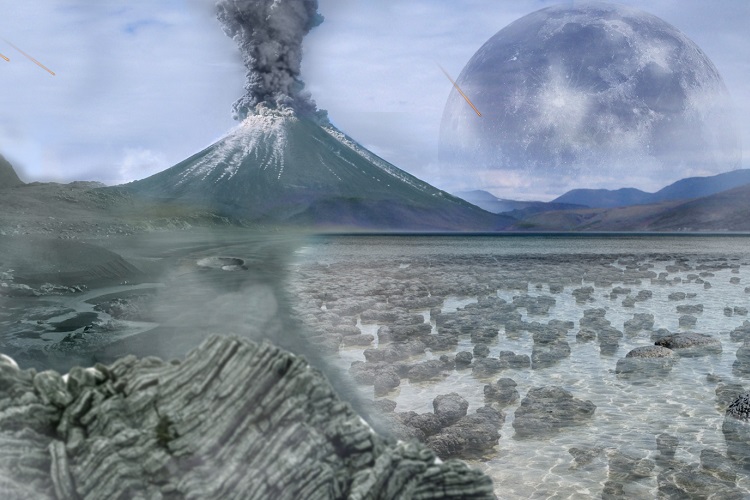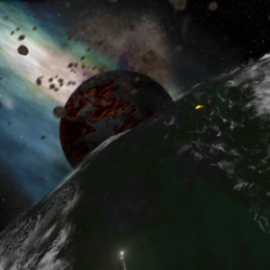New evidence for early life on Earth
 Chemical analyses of some of the oldest pieces of Earth ever discovered suggest our planet was habitable as early as 4.1 billion years ago – 700 million years before the date of the earliest confirmed fossil.
Chemical analyses of some of the oldest pieces of Earth ever discovered suggest our planet was habitable as early as 4.1 billion years ago – 700 million years before the date of the earliest confirmed fossil.
Until relatively recently, it was thought that life on Earth must have evolved after 3.9 billion years ago, as during this time our planet was undergoing a period of intense meteorite impacts, known as the ‘Late Heavy Bombardment’, which was believed to have destroyed all potential for life.
However, earlier this year a study used a genetics-based ‘molecular clock’ to suggest that all life on Earth evolved from a common ancestor that arose before the time of the Late Heavy Bombardment. Following that, this new research presents, for the first time, evidence that the environments necessary to support life were present on Earth’s surface during this period.
Dr Paul Savage of the School of Earth and Environmental Studies at the University of St Andrews said: “Understanding how, when and where life first arose on Earth is fundamental to understanding how life might evolve on other planets in the Universe, but also to understanding what our earliest ancestors were.”
The latest study, involving researchers at the University of St Andrews with colleagues at the University of Rochester, UCLA and the University of Oregon, published in Proceedings of the National Academy of Sciences (PNAS), developed a method to recognise the existence of material involved in water-rock interactions subsequently involved in the melts which formed ancient zircons. Zircons are extremely hardy minerals that can survive multiple periods of weathering untouched, and zircon grains found in the Jack Hills of Western Australia date back to 4.4 billion years old, making them the oldest pieces of our planet so far discovered.
 The research team found evidence for the existence of chemical sediments, such as cherts and Banded Iron Formations on Earth before four billion years ago, implying that the niche for life on Earth existed much earlier than first fossil evidence currently suggests.
The research team found evidence for the existence of chemical sediments, such as cherts and Banded Iron Formations on Earth before four billion years ago, implying that the niche for life on Earth existed much earlier than first fossil evidence currently suggests.
This implies Earth became habitable relatively early on in its history – providing evidence to suggest that other (exo)planets that exist in the ‘goldilocks’ zone could also support life very early in their existences – planets such as Mars.
The Earth is continuously destroying old rocks (and along with them any fossil evidence of life), and forming new ones, in the process of plate tectonics. This means even though the Earth is about 4.5 billion years old, few bona fide terrestrial rocks still exist that are older than 2.5 billion years and, so far, no rocks that date from the first 500 million years of Earth’s history have been found.
The crust or its chemically weathered derivatives likely served as a niche for the origin of life. In particular, hydrothermal settings such as we find today at mid-ocean ridges, and/or chemical sediments such as chert (a silica-rich rock) are common candidates, as these should provide the energy and suitable environmental conditions for life.
Nevertheless, some evidence for Earth’s earliest inhabitants does exist, in the rare ancient rocks and minerals that we do have in our collection.
Because of the lack of any bona fide terrestrial rocks from before four billion years, there is no direct evidence of what Earth’s crust and surface environments looked like from before this time – hence there has, up to now, been no confirmation that the ideal niche(s) for life to thrive existed on the earliest Earth.
Studies have thus turned to (geo)chemical signatures within detrital zircons from this time. Zircons are extremely hardy minerals that can survive multiple periods of weathering untouched, and can be dated using the radiogenic isotopes of uranium.
Analysing the chemistry of these minerals can provide clues to the composition of the melts from which these zircons first formed, and hence the sort of crustal material that was being consumed to form such melts.
The paper, Origin and significance of Si and O isotope heterogeneities in Phanerozoic, Archean, and Hadean zircon, by Dustin Trail, Patrick Boehnke, Paul S Savage, Ming-Chang Liu, Martha L Miller and Ilya Bindeman, is published in PNAS, Please quote the paper's DOI: https://doi.org/10.1073/pnas.1808335115.
Main image courtesy of Tim Bertelink [CC BY-SA 4.0]
Issued by the University of St Andrews Communications Office.